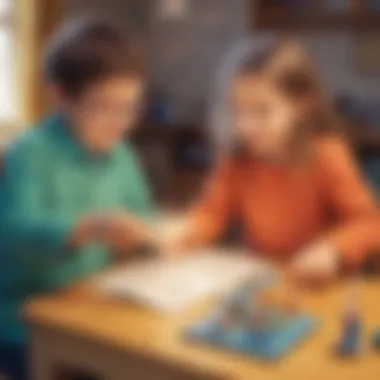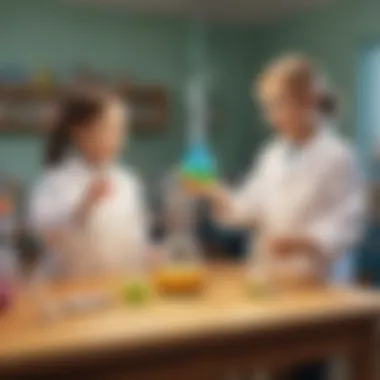Engaging Kindergarten Science Projects for Young Minds


Intro
Engaging young minds with science is crucial at an early age. Kindergarten can serve as the critical foundation for encouraging curiosity about the world. This article will guide you through easy kindergarten science projects that can spark interest and foster learning in a playful setting. Through fun visuals and interactive approaches, children will be able to grasp scientific concepts with simple experiments designed for their level.
Science Fun Facts
Children's natural curiosity often leads to great feelings of wonder. By sharing some intriguing facts, we can relate these feelings to the scientific method. Here are some fun facts to enhance their scientific journey:
- Did you know? Honey never spoils. Archaeologists have found pots of honey in ancient Egyptian tombs that are over 3000 years old and still edible.
- Water is the only substance on Earth that exists as a solid, liquid, and gas in normal conditions. It changes form based on temperature.
- Surprising trivia: Bananas are berries, but strawberries are not!
Engaging young children by sharing these facts can stimulate discussions and questions, enriching their overall science knowledge.
Discover the Wonders of Science
Exploring various scientific concepts is another key component of nurturing young learners. Basic ideas in physics, chemistry, and biology can be simplified in approaches suitable for kindergartners:
- Educational Videos and Animations: Use resources like YouTube or educational platforms where children can visualize concepts, like the water cycle or plant growth.
- Interactive Learning Tools: Hands-on materials such as magnifying glasses, color mixers, or magnifying glasses introduce concepts like light perception and chemical reactions.
- Real-Life Applications of Science: Relate topics to everyday experiences. For example, discussing plants during a nature walk brings to life biology elements and its frameworks.
Science Experiment Showcase
At the heart of engaging with science lies experimentation. The following elements can help facilitate exciting projects:
- Fun and Engaging Experiments: Simple activities like making a homemade volcano with baking soda and vinegar excite kids and teach them about reactions.
- Step-by-Step Instructions: Clearly outlined processes help young learners understand what comes next:
- Materials List: Information about common and easy-to-find materials encourages parents to participate and gather what is needed easily.
- Safety Tips and Precautions: It is quite crucial to inform everyone involved of safe practices with project ideas—make sure children know not to taste substances that are being tested or mixed.
- gather materials
- setup experiment
- conduct observations
- draw conclusions.
It is essential to include parents and educators in the learning cycle. Parents will foster opportunities involving surprises that support education. With acting as mentors during the processes, they relate the learning happening toward how it exists in the real world.
Supporting scientific thought from a young age nurtures creativity, technicality, and interpersonal skills. By balancing guided activities and independent exploration, children take ownership of their learning.
By utilizing these easy projects and engaging discussions, kindergarteners can confidently dive into the vibrant world of science.
Foreword to Easy Science Projects
Science projects for young children represent a gateway to the world of curiosity and discovery. Introducing simple experiments at a kindergarten level encourages kids to explore the fundamental principles of the scientific method. This engagement with exploratory activities not only bolsters their understanding of the world but also cultivates an eagerness to learn. Through hands-on experiences, children can see real-life applications of concepts that they might normally find abstract.
In this article, we highlight several accessible projects tailored for young minds. Engaging these students early fosters critical thinking skills and can lead to lifelong appreciation for scientific inquiry. It’s not just about doing experiments; it's about shaping how young learners perceive complexity and problems in developmental ways. With simple instructions and readily available materials, these projects are designed for both educational settings and home environments. This flexibility is crucial to ensure that active engagement can happen anywhere, enhancing the assimiliation of lessons.
The Importance of Science Exploration
Exploring science is vital as it lays down a foundation for logical reasoning. Kids who investigate the world around them often develop effective problem-solving skills. Furthermore, science exploration provides practical skills and intuitive understandings of nature and technology.
Through direct experiences, children learn how to ask questions and find answers. When they pour water to observe its physical properties, they discover concepts of liquid dynamics. That observational method shapes their understanding of scientific processes and transitions them from passive listeners to active participants.
The active nature of these inquiries promotes natural curiosity. Introducing such projects can inspire profound lifelong learning, serving as a vital component in developing analytical minds overall.
How Science Projects Benefit Young Learners


Science projects not only facilitate understanding practical concepts but also strengthen cognitive and emotional development. In this regard, several substantive benefits arise through engaging science projects:
- Fosters Inquiry: Children learn to ask questions. Inquiry leads to critical thinking pathways, guiding them deeper into problem solving.
- Builds Confidence: Accomplishing a science project nurtures self-assuredness in their abilities. Completing experiments reinforces their skills irrespective of outcome.
- Enhances Collaboration: Working in teams can teach valuable social skills. Cooperative projects require communication and collaborative problem-solving.
- Sparks Creativity: Science is not solely facts and findings. Incorporating imaginative elements makes learning enjoyable, solidifying core principles.
These benefits underscore the richness of learning experiences from hands-on science projects. Nurturing these childhood revelries sets the stage for their perennial enthusiasm for knowledge and understanding.
Engaging children in science through projects ignites a passion for exploration that lasts a lifetime.
Tips for Successful Science Projects
Starting simple science projects can be a fun experience for young minds, but it's essential to approach them with care. When executed correctly, these projects not only educate but also encourage an ongoing interest in science. The core of successful science projects lies in tips that help both parents and children navigate the process smoothly.
Choosing Age-Appropriate Projects
Age-appropriate projects are the most critical factor to consider. Young children in kindergarten benefit greatly from activities that match their developmental stage. Children aged five to six are curious but may struggle with complex concepts. Hence, selecting projects that provide straightforward, observable outcomes is ideal.
For instance, a plant growth experiment is relevant because it allows children to see results over time without needing advanced scientific knowledge. Knowing what tasks suit their skill level allows children to feel accomplished and motivated. Simple rules of thumb include:
- Focus on hands-on activities.
- Look for experiments that allow for short wait periods.
- Choose clear, simple instructions that children can follow or learn with guidance.
Children's attention spans vary. Ensure that the project can hold interest without being overwhelming.
Gathering Materials Efficiently
Efficient material gathering can make or break a project. Children can become disengaged by having to wait long for materials to arrive. Moreover, using freely available items helps remind young learners that science is all around them.
Before any project, create a checklist of necessary materials. Here’s how to do it:
- Confirm what is needed for each project.
- Search around the home for items you might already have, such as plastic bottles for a volcano experiment or soil and seeds for growing plants.
- Make a short trip to a local store if anything is lacking.
- Involve your child in the collection process, explaining why each item is part of the project.
With engaging beginnigs, children are more prone to show curiosity into the nature of each material and, hence, the overall experiment.
Creating a Safe Learning Environment
Safety should always be a priority when conducting science projects with young children. Even activities that seem harmless can pose mushrooms risks if not executed correctly. Examine the setting where the science projects will occur. Ideally, selected areas should be free of distractions and clutter. Explain rules to the children before beginning each project.
To create a safe learning environment:
- Ensure all materials used are age-appropriate.
- Use adult supervision when necessary, especially for actions that might require careful handling, such as mixing substances.
- Establish a clear understanding of what constitutes safe behavior during activities.
By prioritizing safety and fostering an atmosphere conducive to exploration, parent and caregiver will help facilitate children’s growing interest in science.
Simple Science Projects to Try
The section on Simple Science Projects to Try provides an essential foundation for young learners. Engaging in hands-on experiments fosters curiosity and basic science understanding. Young minds benefit significantly from these activities as they encourage exploration and curiosity, major components of effective learning. Moreover, this type of learning allows children to actively participate, thus making science accessible and enjoyable.
Plant Growth Experiment
Necessary Materials


The Necessary Materials for the plant growth experiment are critical for the project's success. They generally include soil, seeds, a container, and water. These components help provide a clear illustration of how plants grow and develop. A plant growth experiment is popular because it delivers visual results over time, enhancing children’s comprehension of living organisms and ecosystems. One advantage is that materials are often found at home or easily sourced, making the project feasible for many families. However, observing the growth takes time, which may test patience in younger children.
Step-by-Step Instructions
The Step-by-Step Instructions for this experiment guide parents and children through the process. Clearly organized guidelines make it easier for children to follow and recreate the experiment independently. This hands-on activity encourages a hands-on approach, allowing youngsters to feel they are scientists conducting real experiments. Since the instructions should be straightforward, this project proves beneficial by presenting uncomplicated actions like filling a pot with soil, planting seeds, and watering them. Yet, it's vital to ensure children understand the need to care for the plant over weeks.
Observations and The Ends
Observations and Conclusions are crucial the educational process of this experiment. They help children reflect on what they see as the plants begin to grow. Keeping a record, such as a simple chart or journal, helps track growth changes. Observing where and how plants thrive can introduce discussions about environmental factors. This encourages critical thinking, making it popular among educators. However, children may need guidance in drawing conclusions at the end of their observations, underscoring the role of adult support in these projects.
Water Cycle in a Bag
Materials Required
The Materials Required for the water cycle in a bag apparatus generally comprise a ziplock bag, water, and a marker. These materials simulate real-world concepts effectively. The visual nature of this project makes it engaging, providing children with a way to observe the water cycle. It's advantageous because all items are inexpensive and readily available, ensuring accessibility to any family. However, ensuring a good seal on the bag is crucial to the project’s success.
Instructions to Follow
The Instructions to Follow clarify how to implement this project methodically. They usually require placing water in the bag, sealing it, and taping it to a sunny window. Using concise and clear guidelines aids comprehension. Children learn via observation as they can witness the evaporation and condensation process. While these steps are straightforward, active adult involvement can help demonstrate understanding and spark discussions about nature.
Understanding Water Cycle Concepts
Understanding Water Cycle Concepts reinforces the interdisciplinary nature of the project. This section highlights fundamental concepts such as evaporation, condensation, and precipitation. It serves as an opportunity to deepen knowledge about atmospheric processes vital for sustaining life. Children will connect observations in the bag to environmental phenomena. However, abstract concepts of science may require more detailed explanatory support from caregivers or educators to ensure clarity and relevance.
Simple Chemical Reactions: Baking Soda and Vinegar
List of Ingredients
The List of Ingredients needed for this reactive project typically includes baking soda and vinegar, ingredients frequently found in homes. Their availability makes this project both enjoyable and practical. It provides an excellent platform for young minds to witness a dramatic reaction. Participating in this experiment holds benefit as children enjoy mixing and observing reactions firsthand. However, it is equally essential to prepare them for safety measures to avoid overspill during the reaction's excitement.
Detailed Procedure
A clearly structured Detailed Procedure is imperative for conducting this experiment effectively. It generally consists of adding baking soda to a container, followed by pouring vinegar to create effervescence. Children can witness fizzing, which captivates attention and intrigue. Simple procedural guides make this experiment easily repeatable. Furthermore, having an easily understandable procedure is beneficial as children can navigate through instructions easily. However, parental oversight is advisable at certain times to project safety mechanisms.
Scientific Explanation of the Reaction
The Scientific Explanation of the Reaction offers young learners insights into the principles behind what they observe. Emphasizing the connection between baking soda and vinegar as acid-base reactions provides scientific meaning and relevance. Relating the fizzing to carbon dioxide production adds depth to their empirical observations, fostering critical insight. Engaging with core scientific concepts allows learners to grasp relationships among common materials in an intuitive way. Some might find comprehending explanations tricky, and supplemental activities or discussions may be required to solidify understanding.
Making a Volcano
Materials You Will Need
To successfully build a baking soda volcano, Materials You Will Need include baking soda, vinegar, food coloring, and a container or mold for the volcano. Creativity in constructing the volcano adds an artistic flair to the project. Construction turns learning into play, and this makes it valuable for young minds. The ease of gathering these materials makes the activity accessible for many. Challenges can arise if the materials do not hold well, requiring tweaks to model design.
Steps to Create Your Volcano
The Steps to Create Your Volcano provide straightforward guidance that usually involves layering materials and the subsequent addition of liquids. Involving children in assembly helps them internally process the sequential steps usually culminating in a lively eruption. Clear directions ensure participants remain focused and active throughout the activity’s arch. Yet, children’s attention may shift when they get excited waiting for the volcano to explode.


Discussing Eruptions and Reactions
Discussing Eruptions and Reactions helps they connect materials’ behavior to greater concepts. This dialogue assists them in recognizing real-world implications of similar reactions seen in nature. Understanding the forces that trigger eruptions and relating them back to cause-and-effect relationships enriches learning thoroughly, enhancing scientific literacy. It would also intensify excitement, but conversations should stick to clarity so as not to lose their interest.
DIY Rainbow with Water and Light
Essential Items
In this project, the Essential Items often needed are a glass of water, a white paper, and sunlight or a flashlight. Combining these elements allows young learners to explore light behavior. It provides a fascinating insight into science while creating vibrant visuals. Availability enhances accessibility, proving to be engaging. However, effective execution heavily relies on conditions like outdoor light or room brightness.
How to Create the Effect
The process described under How to Create the Effect typically includes pouring water and positioning a paper at any correct angle against the sun. This provides instant engagement and frequent successes in recreating the project. Precise directions offer children the assurance to replicate independently. Importanty, they may feel empowered by the illuminated colors presented. Challenges may sometimes arise from finding the best position or having the right amount of sunlight.
Explaining Light Refraction
The Explaining Light Refraction coverage enhances critical learning opportunities that universally introduce optics concepts. Identifying why light changes direction contributing describes the neat effect they see adds academic depth. Linking observations to light it may motivate children’s curiosity in exploring science deeper. However, some explanations may seem abstract, requiring Gladult facilitators to frame questions based around insights to enable well-rounded conclusions.
The Role of Parents and Educators
To create a strong foundation for science learning in young children, the role of parents and educators cannot be overstated. Scientific exploration promotes curiosity, critical thinking, and problem-solving skills, which are crucial as children develop. With the right guidance, adults can cultivate an environment that encourages children to ask questions, be inquisitive, and make observations in a supportive atmosphere. Engaging with children in science projects not only enhances the children’s understanding of basic scientific concepts but also strengthens the bond between the adult and child. Moreover, parental involvement can significantly amplify a child’s educational experiences and overall comprehension of science.
Facilitating Science Learning at Home
At home, parents can play a pivotal role in facilitating science learning. They can create a designated space for science experiments, equipped with essential materials and tools. This space encourages children to explore and satisfy their curiosity freely. Simple practices like allowing them to assist in cooking or gardening are practical examples where science concepts naturally surface. Parents should encourage their children to observe changing seasons, which brings physics and biology lessons to life. Questions about why leaves change colors or how flowers bloom can prompt science discussions, making learning more profound. This type of engagement instills confidence and fosters natural curiosity in young minds.
Incorporating Science into Everyday Life
Incorporating science into daily routines makes it part of the child’s life. From counting ingredients while cooking to observing weather changes or local wildlife, everyday activities offer rich learning mixing with significant life experiences. Activities can include measuring ingredients which incorporates math and science together, or discussing solar energy while talking about how the sun affects weather. Even a simple trip to the grocery store can become educational; sorting items by category or exploring different types of fruits engages children with biological samples while enhancing their observational skills. Engaging in these little moments emphasizes that science is all around us.
Engaging with Young Scientists
Active engagement with young scientists is crucial. Encouraging them to share their findings with family members promotes communication skills while reinforcing their understanding. Classroom projects can also be supported at home. Parents and educators should encourage questioning, rather than just providing answers. This style promotes critical thinking—a vital skill. Hosting small science fairs at home or in school allows children to present their projects fosters their curiosity while building presentation skills. Positive reinforcement for exploration, mistakes, and learning outcomes keeps the momentum ongoing.
Involvement from both parents and educators nurtures a growth mindset that values continuous learning and exploration.
Epilogue and Next Steps
The end of an exploration often marks the beginning of more inquiries. By utilizing simple science projects, kindergartners not only learn fundamental scientific concepts but also discover the excitement and curiosity inherently linked to the process of learning. This concluding section emphasizes the significance of reflecting on the learning outcomes from these projects, as well as the importance of encouraging young learners to delve deeper into science.
Reflecting on Learning Outcomes
Once a project is completed, it's beneficial to reflect on the results and experiences that took place. This time for reflection can help children solidify their understanding and recognize their own skill development. For varied ages, learning outcomes may include of few basic questions:
- What did we observe during this experiment?
- How did our predictions compare to our findings?
- Did anything surprise you?
- What did you enjoy most?
Encouraging children to articulate what they learned can enhance not only their comprehension but also their verbal skills. Even if a project did not yield expected results, discussing setbacks can instill a growth mindset. Learning to experiment, question, and recalibrate denotes progress. Notably, regardless of what successes may arise, promotes an environment where inquiry thrives beyond gainful observation.
Encouraging Further Exploration
Instilling a sense of excitement around science extends far beyond what happens during the project timelines. Activities can harness an opportunity for lasting interest in the subject area. Encouragement from parents or educators encourages young minds to seek science in the world around them, maybe even initiating their own experiments at home. Here are a few suggestions to promote continuous exploration:
- Provide Experiences: Visit a local science museum or nature center to see real-world applications of scientific concepts.
- Suggest Simple Activities: Encourage activities such as planting seeds at home or monitoring local weather to sustain the spirit of exploration.
- Utilize Resources: Helpful materials extensively exist online. Websites like Britannica or Wikipedia have educational articles that further delve into scientific principles.
- Form Study Groups: Facilitating playdates with an educational twist encourages collaboration, exploration, and joy in experimentation.
To conclude, simplifying science means more than merely observing. Engaging young learners with projects nurtures budding scientific curiosity and resilience in facing challenges. With frequent reflection and encouragement toward further endeavors, young minds will be better equipped to understand science as a vibrant exploration that never ends.







